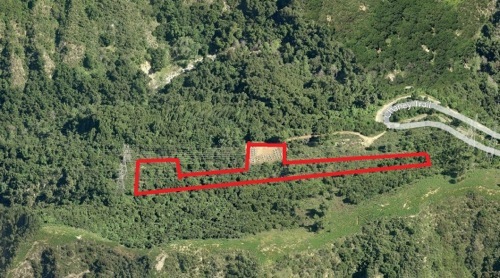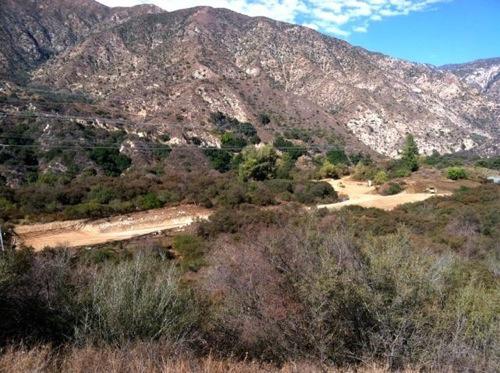
by Timothy Rutt
Local trail users are concerned that Southern California Edison has clearcut and re-graded about two acres of mature forest above Millard Canyon during recent line upgrades, which some say damages an important part of the post-Station Fire ecosystem.
But an Edison spokesman says that the work was approved by all the proper authorities and given proper public notice, and that revegetating the area is part of the plan. In addition, Edison claims that new work methods and technologies used to upgrade the lines has actually minimized the damage that could have been done.
Still, one local trail advocate is concerned that the area’s regrading could have an adverse effect on Millard Creek and the protected wildlife that lives there when the rainy season starts.
Edison recently wrapped up work on the local stretch of the Tehachapi Renewable Transmission Project (TRTP). The project involves upgrading high-power transmission lines that will lead from wind farms in eastern Kern County to San Bernardino County.
The local stretch involved adding and upgrading lines in existing towers in the Angeles National Forest above Altadena. The most visible work in late August and early September involved delivering line workers by helicopter and the occasional explosion as lines were connected through implosive sleeves (story here).
But in a recent email to other trail users and newsgroups, trail advocate Paul Ayers drew attention to the denuded area above Chaney Trail.
In the Sept. 10 email, Ayers said:
Not since [the dynamiting of Rubio Canyon in 1998] have I seen such an act of environmental savagery as SCE has committed in a sweet little valley located just over Sunset Ridge from the La Vina development. For reasons known only to SCE, it has absolutely destroyed, read clear-cut, 2-3 acres of climax habitat in the valley ... a watershed for a tributary of Millard Creek.
[In 1998, a dynamite blast by a repair crew laying pipe for Rubio Canyon Land & Water Association ended up filling that canyon with boulders and buried several waterfalls.]
Ayers, who was a victor in a lawsuit to re-open historic trails in that area that had been illegally closed by the La Vina development, said that he was doing his customary September trail survey of the La Vina East trail when he saw SCE’s construction work and talked to some of the workers there.
He chronicled his visit in a series of photos that show the removal of trees and brush and regrading of the area, which he passed on to local newsgroups.
1. Overview from Sunset Ridge.
2. Blue arrows show graded watercourse
3. Picture of the pull site before construction.
4. View from Sunset Ridge, June 2013
5. View from Sunset Ridge, Sept. 10 2013
6. Area of former bee colony, June 2013
7. Area of former bee colony, Sept. 2013
8. Clearcut stream bed
All photos by Paul Ayers and reprinted with permission.
Ben Wong, spokesman for SCE, told Altadenablog that the area was a “pull site,” where reels of transmission lines were stored and used for stringing new conductor through existing towers.
Wong said that, in addition to being a pull site, some equipment and trucks were stationed there as part of the project.
But all of that activity had been legally noticed and cleared years before, according to Wong. The work needed to get the approval of the California Public Utilities Commission and the Forest Service. Edison filed an environmental review under the California Environmental Quality Act for CPUC as well as an enviornmental impact as required by the National Environmental Policy Act to the Department of Agriculture, the cabinet department in charge of the National Forest Service.
In addition, Wong said, “they held scoping meetings, with notices mailed to 15,000 individuals along the 173 mile route (of the TRTP).” Public notice invovled publication in newspapers along the route, scoping meetings, public meetings and hearings, and public participation meetings, all around the year 2007.
However, something happened in 2009: the Station Fire. Wong said that, because of the fire, publication of the environmental impact statement was delayed. While the California Public Utilities Commission determed that no additional steps needed to be taken (releasing the CEQA report in October, 2009), the Forest Service decided to conduct a separate review, Wong said.
SCE’s consultant for the project, Aspen Engineering, prepared a supplemental environmental impact statement, Wong said, which was finalized in Oct. 2010.
As the August-September 2013 timeframe for construction grew close, Wong said that SCE mailed notices to all property owners within the legally required distance in June of this year as well as running a newspaper ad (see below). Wong said that “we had lmost no responses to newspaper ads.”
“We’ve done what we’ve done to notify people, and frankly we’ve done a pretty good job to minimize environmental impact,” Wong said. Without implosive sleeve technlology, Edison would have to clear several more pull areas, Wong said. “We do one site, instead of four or five.” The new technology allowed them to do a wire pull that was “four to five times what was normal” on one site, Wong said.
Mitigation is an important part of the plans for the site, Wong said. The trees that were removed were catalogued and measured, Wong said. “After the the project is done, we will or will have filed with the Forest Service what ot do to replace those,” at least at a 1:1 ratio or more, depending on species of tree, Wong said.
“There will actually be more trees planted than were removed, albeit a different age and maturity,” Wong said. Once the mitigation plan has been filed and approved by the forest service, the area’s replanting will be monitored for up to five years, Wong said.
But one of the issues that trail advocates want answers to are the contours of the site. Before heavy equipment cleared and regraded the area, it helped feed a stream that fed into MIllard Creek during rainfall. Now, trail users are concerned that it may end up harming the creek’s ecosystem.
According to Ayers, there’s a danger of rainfall from the cleared area washing silt into the creek, which could particularly endanger the protected salamanders who live and breedthere. “Amphibians don’t like silt,” he said.
Wong says that Edison has "worked with the Water Resources Control Board regarding runoff, to insure that it’s appropriately channeled away from environmentally sensitive areas both during course of work [and after] ." Wong said that sediment controls were put into place to prevent silt from running into sensitive areas, and while some features - such the access road -- will stay there permanently, the land will be recontoured to its original setting.
Additional documentation
SCE Newspaper ad to call attention to the TRTP work above Altadena. SCE's Ben Wong said that there was minimal response to this ad.












